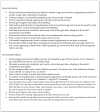Dietary Strategies for Complementary Feeding between 6 and 24 Months of Age: The Evidence
- PMID: 37447369
- PMCID: PMC10346638
- DOI: 10.3390/nu15133041
Dietary Strategies for Complementary Feeding between 6 and 24 Months of Age: The Evidence
Abstract
Suboptimal complementary feeding practices remain highly prevent. This review aims to comprehensively synthesize new emerging evidence on a set of topics related to the selection and consumption of complementary foods. We synthesized evidence related to five key topics focused on nutritional interventions that target the complementary feeding period, based on four systematic reviews that include updated evidence to February 2022. While there have been many studies examining interventions during the complementary feeding period, there is an overall lack of relevant information through which to draw conclusions on the ideal feeding schedule by food type. Similarly, few studies have examined the effects of animal milk versus infant formula for non-breastfed infants (6-11 months), though those that did found a greater risk of anemia among infants who were provided cow's milk. This review highlights a number of interventions that are successful at improving micronutrient status and anthropometry during the complementary feeding period, including fortified blended foods, locally and commercially produced supplementary foods, and small-quantity lipid-based nutrient supplements. Complementary feeding education for caregivers can also be used to improve nutrition outcomes among infants in both food secure and insecure populations.
Keywords: complementary feeding; infants; young child.
Conflict of interest statement
The authors declare no conflict of interest.
Figures















Similar articles
-
Preventive lipid-based nutrient supplements given with complementary foods to infants and young children 6 to 23 months of age for health, nutrition, and developmental outcomes.Cochrane Database Syst Rev. 2019 May 2;5(5):CD012611. doi: 10.1002/14651858.CD012611.pub3. Cochrane Database Syst Rev. 2019. PMID: 31046132 Free PMC article.
-
Sources of energy and nutrients in the diets of infants and toddlers.J Am Diet Assoc. 2006 Jan;106(1 Suppl 1):S28-42. doi: 10.1016/j.jada.2005.09.034. J Am Diet Assoc. 2006. PMID: 16376628
-
Iron requirements of infants and toddlers.J Pediatr Gastroenterol Nutr. 2014 Jan;58(1):119-29. doi: 10.1097/MPG.0000000000000206. J Pediatr Gastroenterol Nutr. 2014. PMID: 24135983 Review.
-
Complementary feeding: a commentary by the ESPGHAN Committee on Nutrition.J Pediatr Gastroenterol Nutr. 2008 Jan;46(1):99-110. doi: 10.1097/01.mpg.0000304464.60788.bd. J Pediatr Gastroenterol Nutr. 2008. PMID: 18162844 Review.
-
Breastfed and Formula-Fed Infants: Need of a Different Complementary Feeding Model?Nutrients. 2021 Oct 24;13(11):3756. doi: 10.3390/nu13113756. Nutrients. 2021. PMID: 34836012 Free PMC article.
Cited by
-
The Influence of Nutritional Status on Brain Development: Benefits of Exclusive Breastfeeding.Pediatr Rep. 2024 Aug 24;16(3):724-735. doi: 10.3390/pediatric16030061. Pediatr Rep. 2024. PMID: 39311324 Free PMC article. Review.
-
Identification of amendable risk factors for childhood stunting at individual, household and community levels in Northern Province, Rwanda - a cross-sectional population-based study.BMC Public Health. 2025 Mar 21;25(1):1087. doi: 10.1186/s12889-025-22329-8. BMC Public Health. 2025. PMID: 40119350 Free PMC article.
-
Biological and Experiential Factors That Impact the Acceptance of Complementary Foods.Ann Nutr Metab. 2025;81(Suppl 2):34-43. doi: 10.1159/000542296. Epub 2025 Feb 24. Ann Nutr Metab. 2025. PMID: 39993384 Review.
-
Incremental financial costs of strengthening large-scale child nutrition programs in Bangladesh, Ethiopia, and Vietnam: retrospective expenditure analysis.Global Health. 2025 Apr 21;21(1):21. doi: 10.1186/s12992-025-01118-3. Global Health. 2025. PMID: 40259386 Free PMC article.
-
Effectiveness of "SAFAL MATRUTV GATS" (Stunting alleviation by facilitation of antenatal-postnatal-interventions for low birth weight reduction) - A peer-led self-empowerment group at rural villages in Eastern Maharashtra: Protocol for a pragmatic cluster randomized controlled trial.J Family Med Prim Care. 2024 Aug;13(8):3156-3164. doi: 10.4103/jfmpc.jfmpc_52_24. Epub 2024 Jul 26. J Family Med Prim Care. 2024. PMID: 39228630 Free PMC article.
References
-
- UNICEF . Improving Young Children’s Diets during the Complementary Feeding Period. UNICEF Programming Guidance; New York, NY, USA: 2020.
-
- WHO Complementary Feeding. [(accessed on 3 May 2022)]. Available online: https://www.who.int/health-topics/complementary-feeding#tab=tab_1.
Publication types
MeSH terms
LinkOut - more resources
Full Text Sources
Medical

